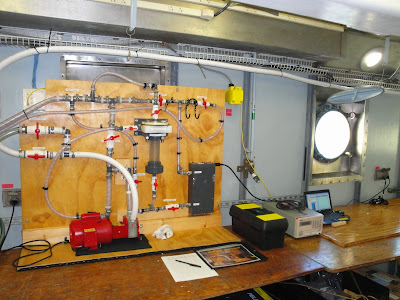Guest Blogger: Dr. Ben Hodges (WHOI)
As the Endeavor
steams along, seawater is drawn in continuously and analyzed with onboard
sensors. We left Ponta Delgada yesterday
morning, heading south-southwest toward a mooring that needs a repair. When we arrive there in a few days, we’ll
have a record of changes in salinity, temperature, and chlorophyll
concentration every second along a line over a thousand miles long. This line is about 5 meters below the surface
of the ocean, since the seawater intake in the bottom of the hull is about that
deep.
Wind tends to stir up the upper layer of the ocean, keeping
it homogenous, so the water 5 meters deep and right at the surface are usually
pretty much the same. On very calm days
though, there are sometimes big changes near the surface, even in the top
meter. Right after it rains, there might be a
“puddle” of fresher water sitting on top of the saltier water below; or, on a
hot sunny day, evaporation from the surface might make it saltier than the
deeper water. We’re using a “snake” to suck up water from just beneath the
surface, so we can keep track of these changes in salinity as we steam
along. The snake is a hose that drags
along from the end of a long boom, which keeps it away from the side of the
ship—too close, and it might take in deeper water churned up by the Endeavor.
Seawater enters the snake from a few inches beneath the
surface through small holes in the bottom of the hose. Inside the ship, a pump moves the water
through a system that removes air bubbles, and then measures the amount of
dissolved salt it contains.


No comments:
Post a Comment